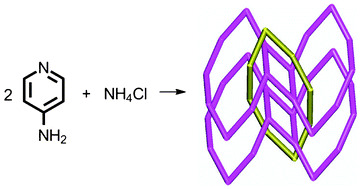Homoconjugated 4-aminopyridine salts: influence of anions on network topology†
Abstract
The homoconjugated 4-aminopyridinium cation, (4-AP)2H, has been examined as a tecton for hydrogen bonded networks. The reaction of 4-aminopyridinium with ½ equivalent of NH4X (X = Cl, Br, BF4 or PF6) produced [(4-AP)2H]X salts, which were characterized by single crystal X-ray crystallography. All four compounds crystallized with 4-connected, uninodal hydrogen bond network topologies. The BF4 and PF6 salts formed interpenetrated SrAl2 and diamond networks, respectively. Both halide salts displayed an unprecedented non-interpenetrated, self-catenated network topology.


 Please wait while we load your content...
Please wait while we load your content...